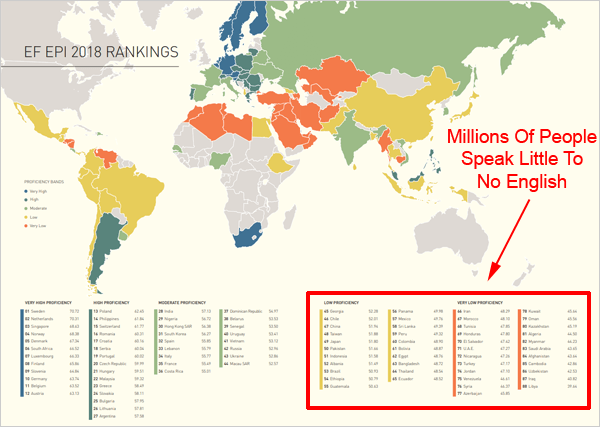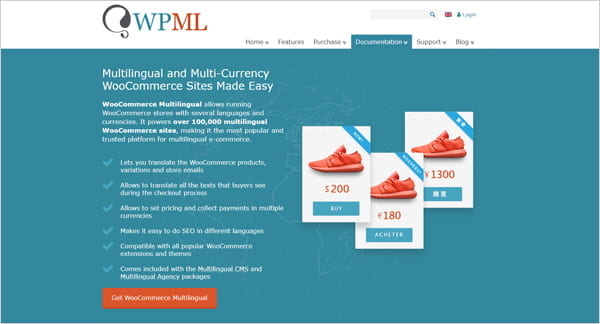Want to expand your marketplace… to the entire world? A multilingual eCommerce store gives you the capability to sell to markets in every part of the globe – anywhere customers can access the internet!
Every website can be accessed by anyone anywhere in the world (unless, of course, it’s been blocked by another country), so reaching a worldwide audience isn’t a problem. Connecting with a worldwide audience, however, is. If you plan to sell your products or services to a global customer base, here are some things to consider.
Does Your Web Store Speak Their Language?
The first of these is language. Let’s say you’re in an English-speaking country. Will you be publishing information on your store in English only? Only 20% of the world’s population speaks English, so if you plan to sell products online, that’s 80% of the global market you could be missing out on selling to.

Does Your Web Store Sell In Their Currency?
The second thing to consider is currency. If visitors are browsing your store from another country, displaying items with prices in their own currency is not only helpful, it can also help boost your sales.

For more information in this area, check out this post on WordPress Currency Conversion Plugins.
Does Your Web Store Ship To Their Country?
The third thing you need to consider, especially if selling physical products, is shipping. It’s one thing to make a promise, and another to deliver. We’ve written a separate post covering the best eCommerce shipping plugins for WordPress to help you with this step of the process.
WordPress Multilingual Plugins
As our focus is on creating a multilingual online store, let’s take a look at some plugins you can use to add multilingual capabilities to your WordPress eCommerce store:
-
WPML

WPML is a plugin that allows you to build multilingual sites with WordPress, allowing you to translate every aspect of your site, right from within the WordPress admin panel. You’ll be able to translate pages, posts, custom types, taxonomy, menus and even the text of your WordPress theme, plus collect payments in different currencies.
Adding this plugin to your WordPress site with WooCommerce installed gives you an eCommerce store with an instant global presence.
If you want to use different media (images) for different translations of a product, you will also need to install WPML Media.
-
WooCommerce Multilingual

Once you have installed WPML and WooCommerce on your WordPress site, install the WooCommerce Multilingual plugin to help you connect everything together and set up a multilingual store.
To use WooCommerce Multilingual, you need to have the following plugins installed and activated:
- WPML 4.0 or above
- WPML String Translation 2.8 or above
- WPML Translation Management 2.6 or above
- WooCommerce 3.3.0 or later
Key features of this plugin include translation of all WooCommerce products (simple, variable, grouped, external) and easy translation management for products, categories and attributes. With this plugin installed, the same language is maintained through the checkout process and clients and admins receive emails in their language. Additionally, WooCommerce Multilingual allows inventory tracking without breaking products into languages and lets you run a single WooCommerce store with multiple currencies.
WooCommerce Multilingual is fully compatible with all popular WooCommerce extensions.
-
TranslatePress

TranslatePress lets you translate your WooCommerce store directly from the front-end, using an intuitive visual translation interface.
You can translate everything from products and product details, shop, checkout, or cart pages. All you need to do is navigate your store using the visual translation interface, click to select a string, enter its translation, save and move to the next one.
To speed things up you can also use the built-in automatic translation functionality to automatically translate your WooCommerce store, then manually go back and edit only the text that doesn’t look accurate. TranslatePress is available for free at wp.org.
The premium version comes with pro addons for extended SEO support, automatic user language detection, ability to create translator accounts, and more.
-
Translate WordPress – Google Language Translator Plugin

Google Language Translator plugin (now a part of GTranslate) powers more than 500,000 multilingual websites worldwide. It adds free Google automatic machine translation to your site, including the ability to translate WooCommerce shops. The paid version of the plugin is WooCommerce compatible and adds multilingual SEO capabilities and neural machine translations with human level translation quality.
-
MultilingualPress

MultilingualPress works differently than the other plugins described above. It runs on WordPress Multisite, enabling you to create a network of sites, run each language in a separate site, and connect the content in a lightweight user interface. The benefits of this approach are less performance issues as only one language is loaded per site, no change to WordPress Core when updating your WordPress version or conflicts with other well-written plugins, and the flexibility of customizing each language site with different designs, different functions or plugins, and separate settings for currency, taxes, shipping, etc.
Additional features of this plugin include the choice of almost 900 languages, ability to create an unlimited number of related language sites, easy switching on product and page level, translate posts, terms and built-in and custom content types, SEO-friendly URLs & Permalinks, easy site duplication, and user-specific language settings for the backend, so every user can choose a preferred language for their user interface.
Adding multilingual capabilities to your eCommerce store can open up so many new possibilities to grow and expand your business worldwide. With WordPress, the world is truly your oyster. We hope the above information has given you some pearls of wisdom to steer you in the right direction.
If you need help building your eCommerce site, make sure to read our comprehensive guide to planning an eCommerce store with WordPress.
Source: premium.wpmudev.org